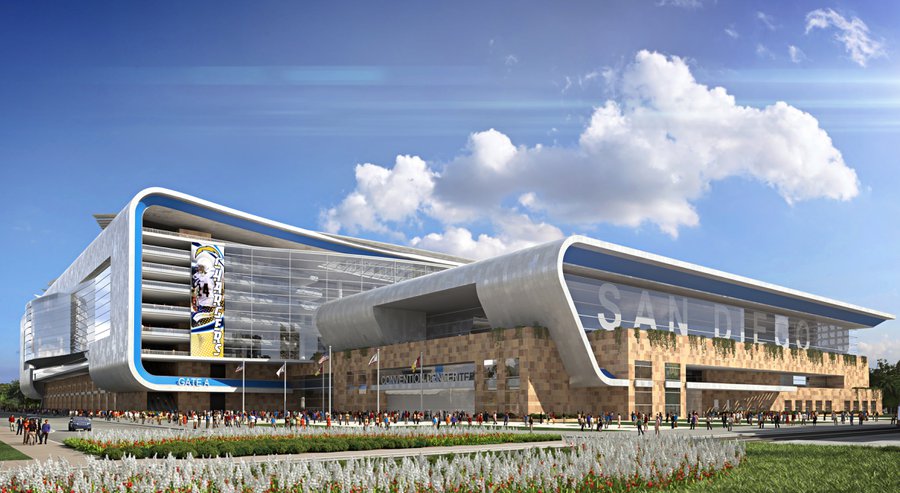The San Diego Chargers announced their Citizens’ Initiative for a downtown, 65,000-seat stadium and convention center on Wednesday, putting the fate of the Chargers in San Diego squarely in the hands of the voters.
The Chargers, who have been granted permission by the NFL to move to Los Angeles and share a stadium with the Rams, are instead looking to find a new, permanent home in San Diego to replace dilapidated Qualcomm Stadium in Mission Valley.
“We are excited to report that our Citizens’ Initiative has been finalized,” said Chargers Chairman Dean Spanos. “We believe this is a great opportunity for the community to come together and create something special: an iconic, modern multi-purpose venue while also supporting and expanding our tourism and convention industries.”
The formal release of the $1.8 billion proposal in Thursday’s San Diego Union-Tribune, with its centerpiece a hotel tax increase of four percent to 16.5 to cover $1.15 billion in publicly issued bonds, starts the clock on a 21-day waiting period, after which the team can begin collecting the 66,447 valid signatures needed from registered San Diego city voters by mid-June in order to place the measure on the ballot in November.
The Chargers have until January to pursue a stadium deal in San Diego. Should the ballot measure pass in November, the Chargers would be granted a one-year extension. If the measure fails, the Chargers could still pursue joining the Rams in their $2.6 billion stadium plan in Los Angeles.
Construction of a new downtown stadium would likely begin in 2020.
“We hope that the Citizens’ Initiative will be before the voters on November 8, 2016, the date of the Presidential Election,” Fred Maas, special advisor to owner Dean Spanos, said in a statement released by the Chargers. “Our goal would be to collect considerably in excess of the required number of signatures to ensure that we will have in excess of what we need to qualify for the ballot. San Diego election law requires the publication of the Citizens’ Initiative in the newspaper. Once that occurs this week, then signature gathering can begin on the 21st day after that publication.”
According to the proposal, the Chargers would lease the stadium, located just east of Petco Park, for 30 years from the point of construction completion and would not relocate over that same period. The city would own and operate the stadium and convention center, with the Chargers keeping gameday and NFL-related revenue.
The stadium would contain 65,000 seats, bumping up to 75,000 for a Super Bowl, which the NFL almost certainly would award to San Diego for the first time since 2003. The NFL has since withheld Super Bowls from San Diego, which previously has hosted three, because of the outdated condition of Qualcomm Stadium.
The downtown stadium would also provide the Chargers with revenue streams such as seat licensing and luxury suites, allowing Spanos to recoup much of the $350 million he will invest in the project. That total, plus $300 million from the NFL, would combine with the $1.15 billion in hotel tax revenue to fund the $1.8 billion price tag.
The convention center would cover roughly 385,000 square feet, including 225,000 of exhibit space as part of an expansion of the center toward San Diego Bay. That project is one the city has long endeavored to undertake, but was thwarted because hotelier-approved tax increases, rather than voter-approved, was ruled unconstitutional.
But much about the project and the vote itself remains unclear. For instance, it has yet to be determined if the ballot measure will require a two-thirds majority of the vote to pass, or whether it will be a 50 percent-plus-1 scenario.
Two weeks ago, a California state appellate court ruled that a citizens’ initiative to tax marijuana dispensaries required just the simple majority, a departure from the norm. But Maas told reporters on Tuesday the team is operating under the assumption that the 2/3 threshold will be in place.
Also undecided is whether the stadium and convention center will a stacked complex or side-by-side. And the proposal also requires the San Diego Metropolitan Transit System to sell an eight-acre plot within the 15-acre project area and relocate the yard that houses 180 buses and administrative offices. The MTS has said the relocation could take as long as five years to complete, potentially pushing completion of the stadium and convention center to as far back as 2023.

